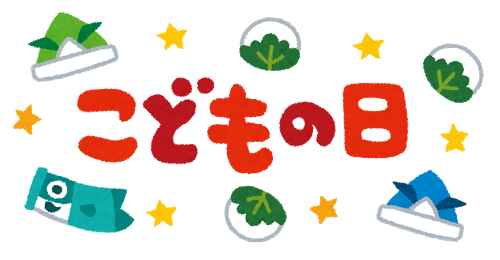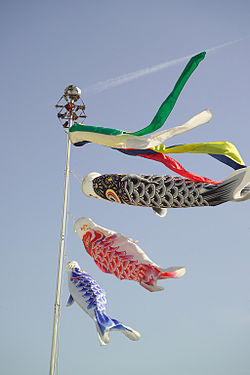
Every year in Japan on the 5th of May, Children’s Day (子供の日) is celebrated. The aim is to celebrate boys, girls, mothers, and fathers. It wasn’t always gender neutral, though. Originally called tango no sekku (Boy’s Day) and referred to as the feast of banners, traditionally it only celebrated boys and their fathers.
Girls also have their own day of celebration, Hinamatsuri, which you may know as the doll festival celebrated on March 3rd. In 1948, the Japanese government decided it didn’t matter if girls got two days of celebration, and changed Boy’s Day to become Children’s Day.

Photo from Wikipedia
The way the Japanese celebrate Children’s Day doesn’t differ to Boy’s Day though, apart from now being gender inclusive. On this day, households fly carp flags outside their house. The largest carp at the top is a signifier of the father, followed by increasingly smaller carps. The next down from the father carp is the mother, then followed by a carp for each child (with appropriate size and colour).
Other symbols used in the celebrations include a Kintaro doll, a character from Japanese folklore that possesses incredible strength and bravery. These dolls are put on the carp in a way that makes it look like Kintaro is riding the carp. If there’s a newborn baby boy, some families fill the son’s bedroom with Kintaro dolls to make sure he grows up strong and brave. Traditional military helmets are also displayed as symbols of strength.

Picture: Kintaro is said to have ridden a bear instead of a horse. 1770 wood block print, Yasunobu.
As for food, mochi is a popular choice with several variations. Kashiwa mochi is filled with red beans and wrapped in an oak leaf, and chimaki has a sweet rice paste filling wrapped in iris or bamboo leaves.
Children’s Day is also a part of Golden Week – a magical time in Japan when there are so many public holidays one after the other, everyone just takes the whole week off work. Sounds pretty golden, right? Beginning with the Emperor’s birthday (celebrated April 29), and following with the Constitution Memorial Day (May 3), Greenery Day Midori no Hi (May 4) and finally Children’s Day.
Just like Australia, if a public holiday falls on a weekend, you’ll be compensated with a Friday or Monday off, and there’s also a rule that if there are two public holidays with one day in between, that day also becomes a public holiday. It’s a pretty sweet setup that we could learn a lot from.

Picture: Kashiwa mochi. Credit.
Considering the culture of Japanese business, Golden Week is often the longest holiday that Japanese people get, and they use this time to travel, so hotels and flights are usually fully booked. If you wish to travel during this time, we suggest you book well in advance!